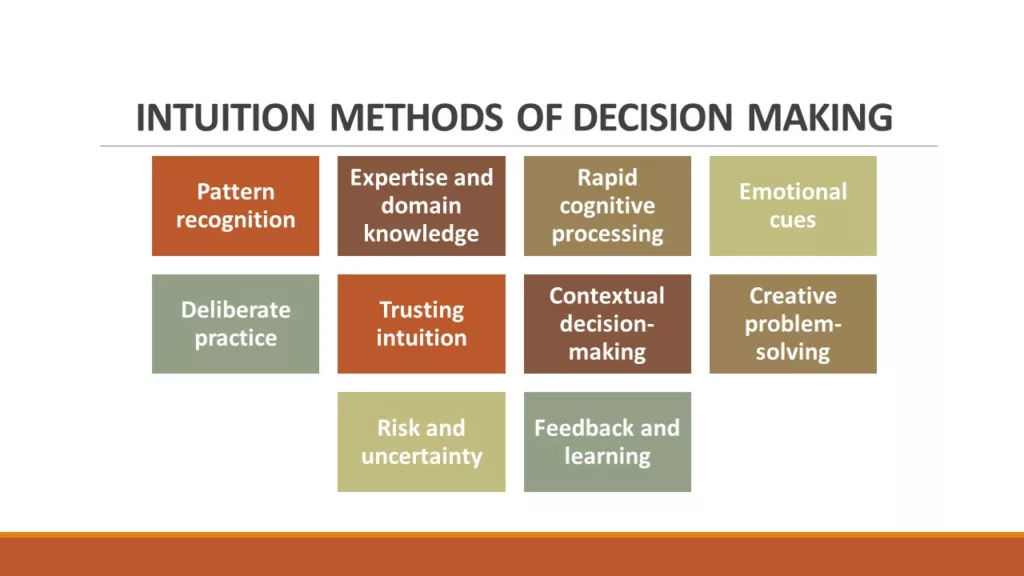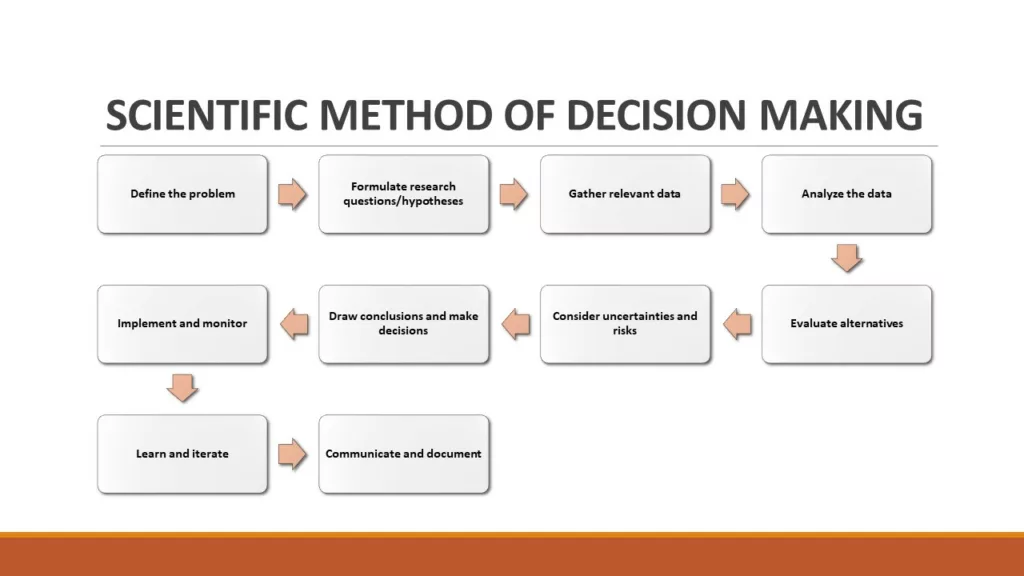INTUITION AND SCIENTIFIC METHODS OF DECISION MAKING
INTUITION METHODS OF DECISION MAKING
Intuition, often referred to as intuitive decision-making, is a form of decision-making that relies on immediate insights, gut feelings, or unconscious knowledge rather than a deliberate, analytical process. While it may seem less structured compared to the scientific approach, intuition can be a valuable method of decision-making in certain situations. Here are some key aspects and methods associated with intuitive decision-making:

- Pattern recognition: Intuitive decision-making often involves the recognition of patterns and the ability to quickly connect seemingly unrelated information or experiences. Through years of experience and exposure to various situations, individuals develop a sense of familiarity that allows them to recognize patterns and make quick judgments based on those patterns.
- Expertise and domain knowledge: Intuition is often associated with individuals who possess deep expertise and domain knowledge in a particular field. Their extensive experience allows them to develop a mental database of patterns, which enables them to make intuitive decisions in their area of expertise.
- Rapid cognitive processing: Intuitive decision-making is characterized by fast, subconscious cognitive processing. It involves accessing information stored in long-term memory without the need for conscious effort or step-by-step analysis. This rapid processing allows for quick decision-making in time-sensitive situations.
- Emotional cues: Intuition can also be influenced by emotional cues or instincts. Feelings and emotions can serve as signals that guide decision-making. For example, a person may have a gut feeling that something is not right about a particular situation, leading them to make an intuitive decision based on that emotional response.
- Deliberate practice: Developing intuitive decision-making skills often requires deliberate practice. This involves actively engaging in situations and reflecting on the outcomes to refine one’s intuitive abilities. Through repeated exposure and reflection, individuals can fine-tune their intuition and become more effective decision-makers in their respective domains.
- Trusting intuition: Intuitive decision-making involves trusting one’s instincts and being comfortable with uncertainty. It requires individuals to have confidence in their own judgment and to rely on their intuition even when faced with limited information or ambiguous situations.
- Contextual decision-making: Intuitive decision-making is highly contextual, meaning it can be influenced by the specific circumstances or environment in which a decision is made. Factors such as time pressure, familiarity with the situation, and the level of complexity can impact the reliance on intuition versus a more analytical approach.
- Creative problem-solving: Intuition can be instrumental in creative problem-solving. It can provide unconventional insights and perspectives that may not be readily accessible through analytical thinking alone. Intuitive decision-making can help break free from rigid thought patterns and foster innovative solutions.
- Risk and uncertainty: Intuition can be particularly useful when dealing with situations involving high levels of risk or uncertainty. In such cases, relying on intuition can provide a quick and instinctive response, which may be necessary when there is limited time for extensive analysis or when there is a lack of complete information.
- Feedback and learning: Intuitive decision-making is an ongoing learning process. Individuals can refine their intuitive abilities by seeking feedback on their decisions and learning from the outcomes. This feedback loop helps individuals recognize the strengths and limitations of their intuition and make adjustments accordingly.
It is important to note that while intuition can be a valuable decision-making method, it is not infallible. Intuition can be subject to biases, cognitive shortcuts, and errors. Therefore, it is crucial to balance intuitive decision-making with analytical thinking and evidence-based approaches, especially in complex and consequential situations where a more systematic approach is warranted.
SCIENTIFIC METHOD OF DECISION MAKING
Scientific methods of decision-making involve the application of systematic and evidence-based approaches to gather and analyze relevant data, evaluate alternatives, and make informed decisions. These methods aim to minimize biases, subjectivity, and uncertainties, and rely on empirical evidence and rigorous analysis. Here are key components and steps involved in scientific methods of decision-making:

- Define the problem: Clearly articulate the decision problem or question at hand. This involves identifying the specific issue, goal, or objective that requires a decision to be made.
- Formulate research questions/hypotheses: Develop specific research questions or hypotheses that can guide the data collection and analysis process. These questions should be structured, focused, and relevant to the decision problem.
- Gather relevant data: Identify and collect relevant data that are necessary to inform the decision-making process. This may involve conducting surveys, experiments, interviews, or gathering existing data from reliable sources. The data collected should be reliable, valid, and representative of the problem under investigation.
- Analyze the data: Apply statistical and analytical methods to analyze the collected data. This may involve techniques such as descriptive statistics, inferential statistics, regression analysis, or data visualization to identify patterns, relationships, and trends in the data.
- Evaluate alternatives: Generate and evaluate potential alternative options or courses of action. This can involve comparing the pros and cons of different choices, conducting cost-benefit analyses, or using decision-making frameworks such as decision trees or multi-criteria decision analysis.
- Consider uncertainties and risks: Assess the uncertainties and risks associated with each alternative. This involves identifying potential sources of uncertainty, estimating their impact, and considering risk mitigation strategies. Tools such as sensitivity analysis, scenario planning, or Monte Carlo simulations can be employed to understand and manage uncertainties.
- Draw conclusions and make decisions: Based on the analysis of the data and evaluation of alternatives, draw conclusions and make informed decisions. This involves synthesizing the findings, considering the trade-offs and uncertainties, and selecting the most appropriate option based on the available evidence.
- Implement and monitor: Implement the chosen decision and monitor its outcomes and effectiveness. This involves tracking and evaluating the results, comparing them to the expected outcomes, and making adjustments if necessary.
- Learn and iterate: Reflect on the decision-making process, learn from the outcomes, and iterate as needed. This involves assessing the effectiveness of the decision-making process and identifying opportunities for improvement in future decision-making endeavors.
- Communicate and document: Communicate the decision, the rationale behind it, and the supporting evidence to relevant stakeholders. Document the decision-making process, including the data collected, analysis methods used, and the assumptions made. This documentation serves as a reference for future decisions and allows for transparency and accountability.
Scientific methods of decision-making prioritize evidence-based approaches, systematic analysis, and critical thinking. By following these steps, individuals and organizations can make more objective, informed, and defensible decisions that are grounded in empirical evidence and rigorous analysis.